Managing Across Cultures
VerifiedAdded on 2023/04/21
|14
|4277
|75
AI Summary
This report explores the importance of managing across cultures in today's global business world. It discusses the concept of culture profiling and its values, focusing on Hofstede's Cultural Dimensions Theory. Examples of companies using cultural profiling are also provided.
Contribute Materials
Your contribution can guide someone’s learning journey. Share your
documents today.
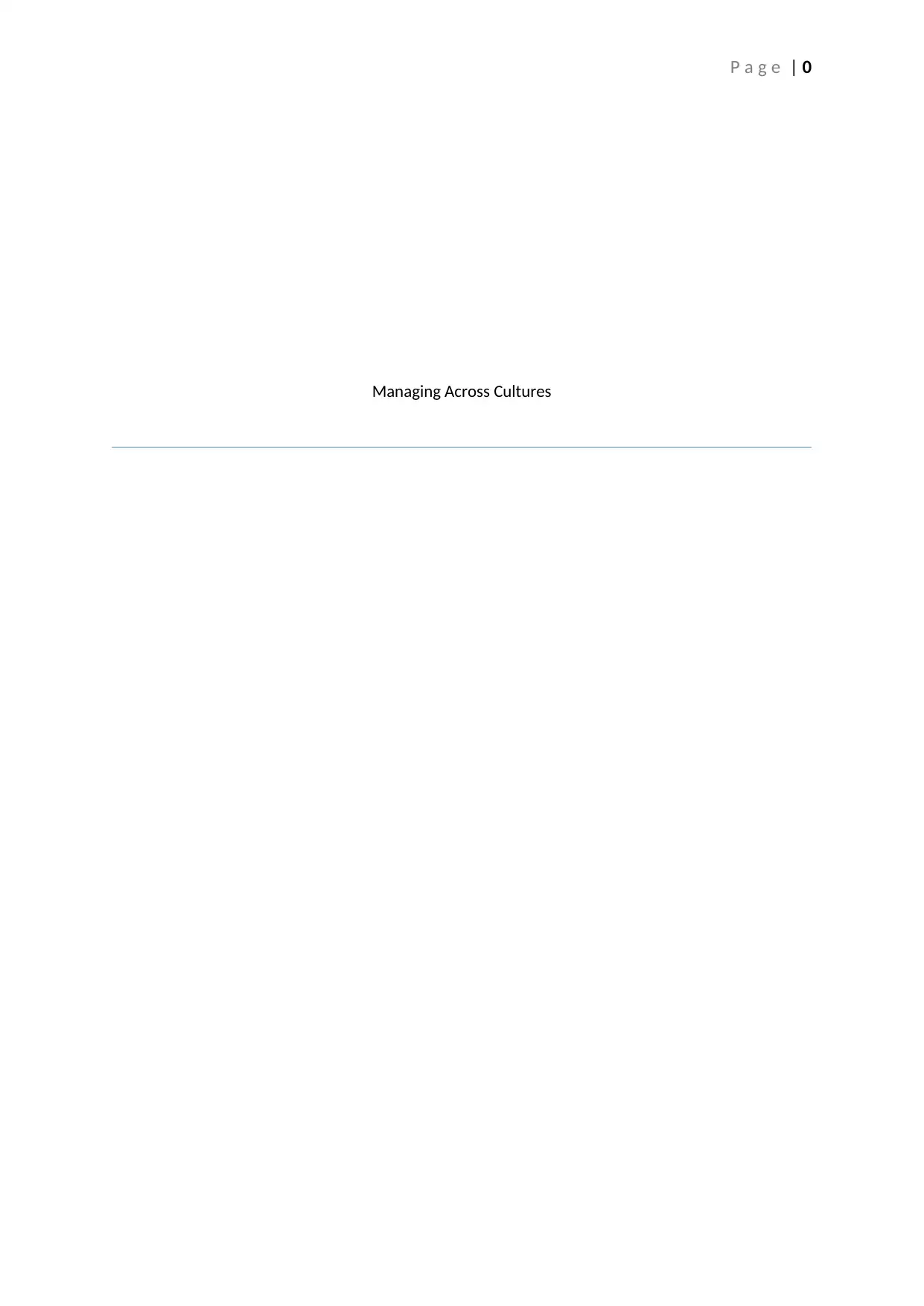
P a g e | 0
Managing Across Cultures
Managing Across Cultures
Secure Best Marks with AI Grader
Need help grading? Try our AI Grader for instant feedback on your assignments.
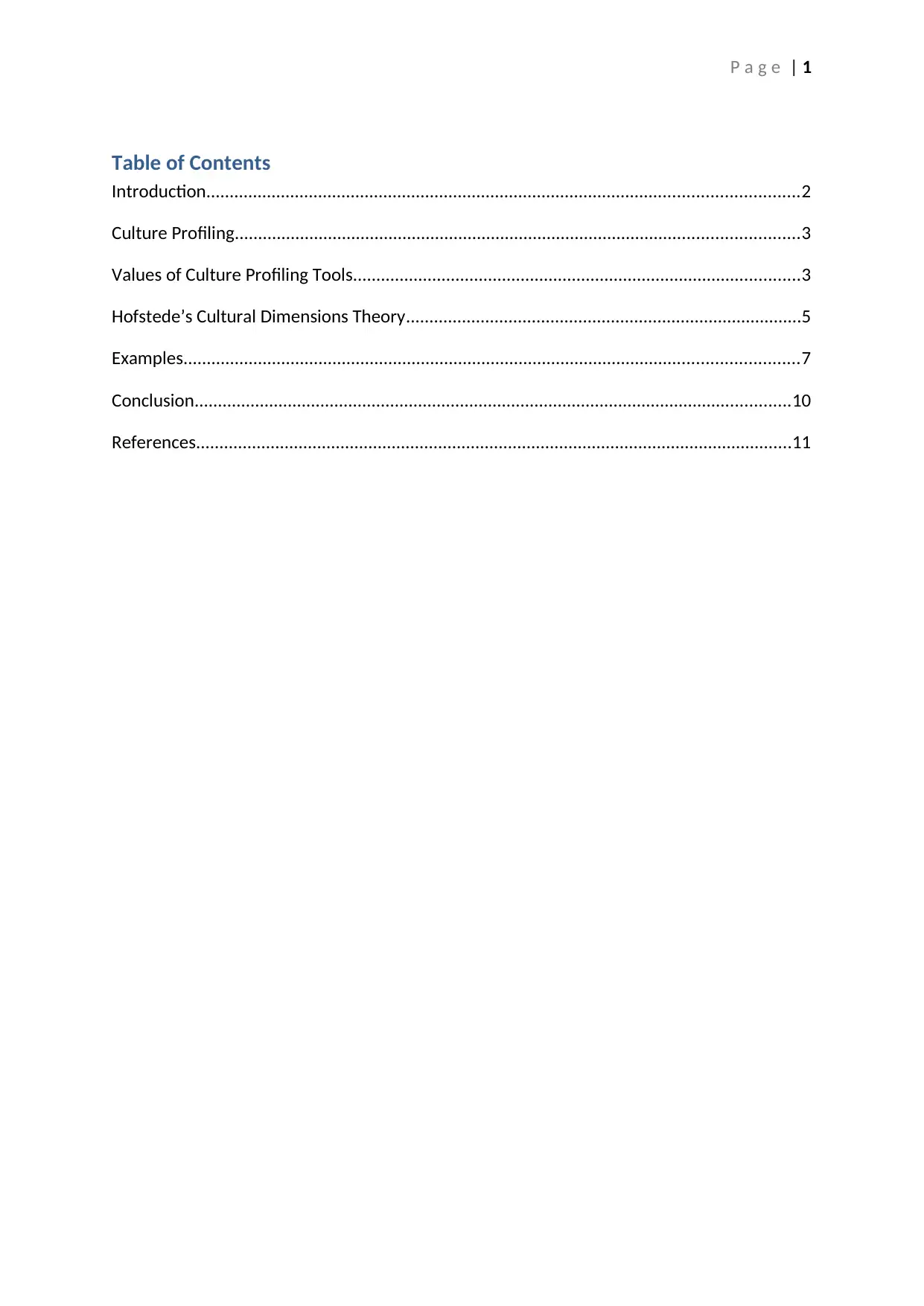
P a g e | 1
Table of Contents
Introduction...............................................................................................................................2
Culture Profiling.........................................................................................................................3
Values of Culture Profiling Tools................................................................................................3
Hofstede’s Cultural Dimensions Theory.....................................................................................5
Examples....................................................................................................................................7
Conclusion................................................................................................................................10
References................................................................................................................................11
Table of Contents
Introduction...............................................................................................................................2
Culture Profiling.........................................................................................................................3
Values of Culture Profiling Tools................................................................................................3
Hofstede’s Cultural Dimensions Theory.....................................................................................5
Examples....................................................................................................................................7
Conclusion................................................................................................................................10
References................................................................................................................................11
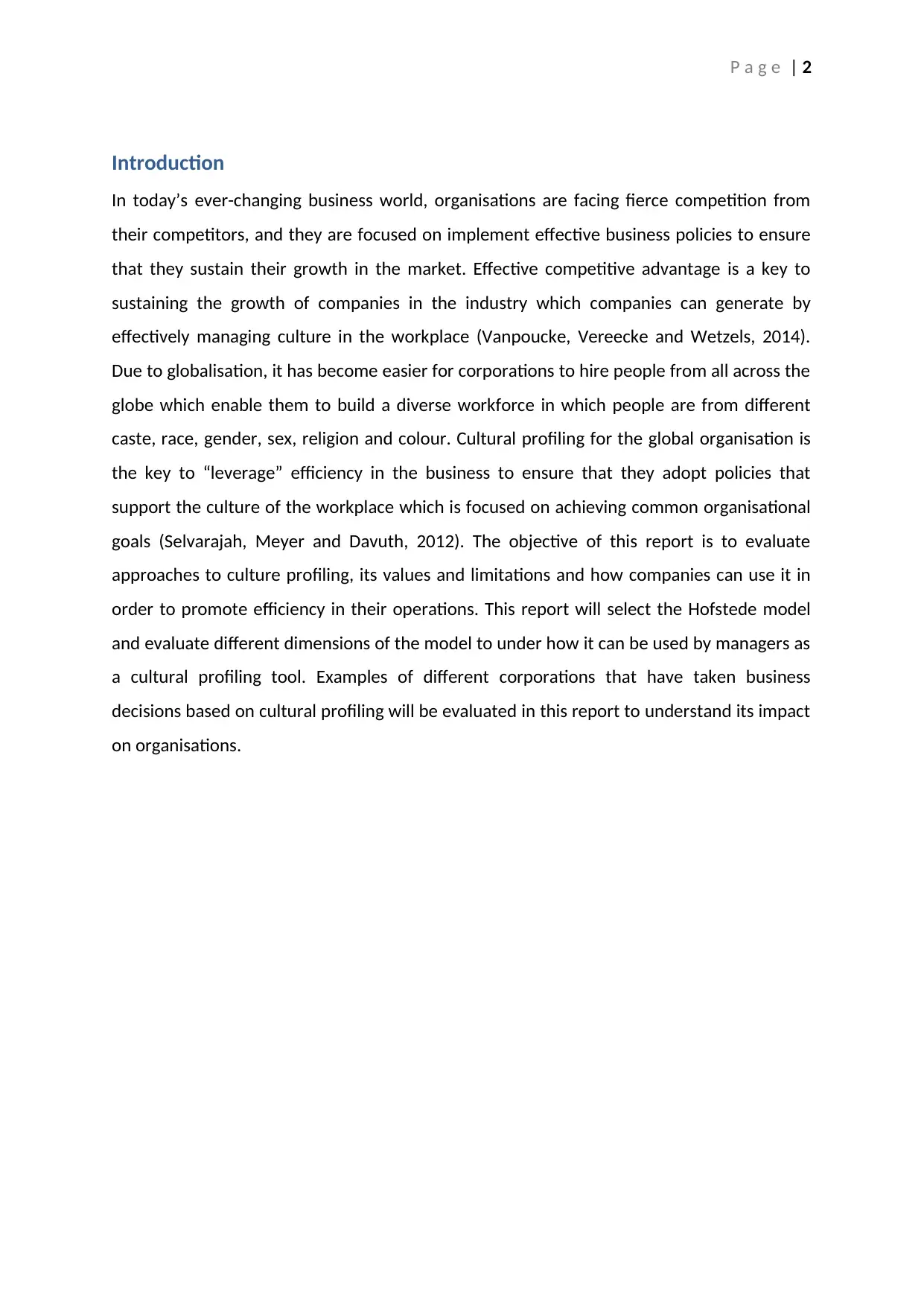
P a g e | 2
Introduction
In today’s ever-changing business world, organisations are facing fierce competition from
their competitors, and they are focused on implement effective business policies to ensure
that they sustain their growth in the market. Effective competitive advantage is a key to
sustaining the growth of companies in the industry which companies can generate by
effectively managing culture in the workplace (Vanpoucke, Vereecke and Wetzels, 2014).
Due to globalisation, it has become easier for corporations to hire people from all across the
globe which enable them to build a diverse workforce in which people are from different
caste, race, gender, sex, religion and colour. Cultural profiling for the global organisation is
the key to “leverage” efficiency in the business to ensure that they adopt policies that
support the culture of the workplace which is focused on achieving common organisational
goals (Selvarajah, Meyer and Davuth, 2012). The objective of this report is to evaluate
approaches to culture profiling, its values and limitations and how companies can use it in
order to promote efficiency in their operations. This report will select the Hofstede model
and evaluate different dimensions of the model to under how it can be used by managers as
a cultural profiling tool. Examples of different corporations that have taken business
decisions based on cultural profiling will be evaluated in this report to understand its impact
on organisations.
Introduction
In today’s ever-changing business world, organisations are facing fierce competition from
their competitors, and they are focused on implement effective business policies to ensure
that they sustain their growth in the market. Effective competitive advantage is a key to
sustaining the growth of companies in the industry which companies can generate by
effectively managing culture in the workplace (Vanpoucke, Vereecke and Wetzels, 2014).
Due to globalisation, it has become easier for corporations to hire people from all across the
globe which enable them to build a diverse workforce in which people are from different
caste, race, gender, sex, religion and colour. Cultural profiling for the global organisation is
the key to “leverage” efficiency in the business to ensure that they adopt policies that
support the culture of the workplace which is focused on achieving common organisational
goals (Selvarajah, Meyer and Davuth, 2012). The objective of this report is to evaluate
approaches to culture profiling, its values and limitations and how companies can use it in
order to promote efficiency in their operations. This report will select the Hofstede model
and evaluate different dimensions of the model to under how it can be used by managers as
a cultural profiling tool. Examples of different corporations that have taken business
decisions based on cultural profiling will be evaluated in this report to understand its impact
on organisations.
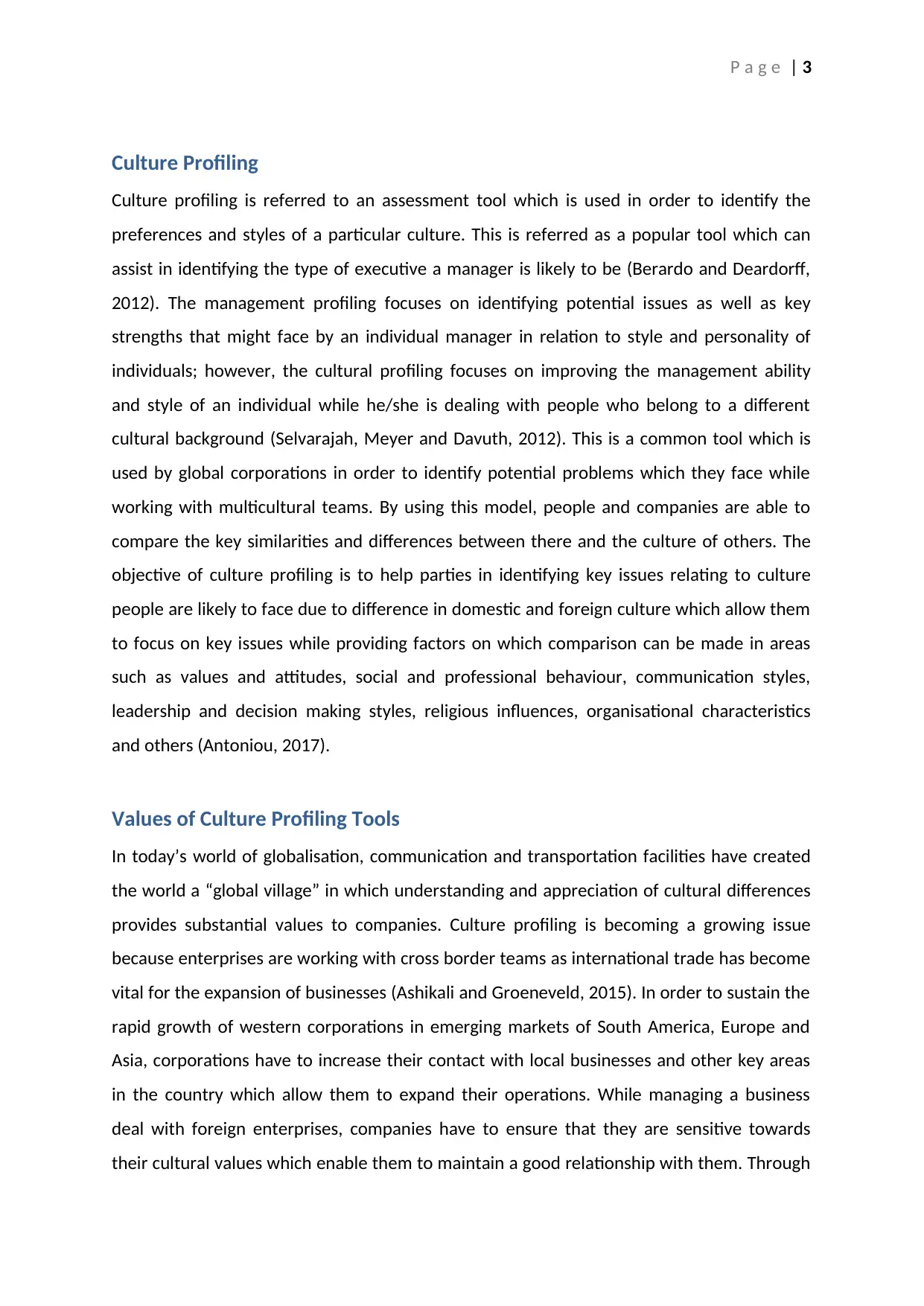
P a g e | 3
Culture Profiling
Culture profiling is referred to an assessment tool which is used in order to identify the
preferences and styles of a particular culture. This is referred as a popular tool which can
assist in identifying the type of executive a manager is likely to be (Berardo and Deardorff,
2012). The management profiling focuses on identifying potential issues as well as key
strengths that might face by an individual manager in relation to style and personality of
individuals; however, the cultural profiling focuses on improving the management ability
and style of an individual while he/she is dealing with people who belong to a different
cultural background (Selvarajah, Meyer and Davuth, 2012). This is a common tool which is
used by global corporations in order to identify potential problems which they face while
working with multicultural teams. By using this model, people and companies are able to
compare the key similarities and differences between there and the culture of others. The
objective of culture profiling is to help parties in identifying key issues relating to culture
people are likely to face due to difference in domestic and foreign culture which allow them
to focus on key issues while providing factors on which comparison can be made in areas
such as values and attitudes, social and professional behaviour, communication styles,
leadership and decision making styles, religious influences, organisational characteristics
and others (Antoniou, 2017).
Values of Culture Profiling Tools
In today’s world of globalisation, communication and transportation facilities have created
the world a “global village” in which understanding and appreciation of cultural differences
provides substantial values to companies. Culture profiling is becoming a growing issue
because enterprises are working with cross border teams as international trade has become
vital for the expansion of businesses (Ashikali and Groeneveld, 2015). In order to sustain the
rapid growth of western corporations in emerging markets of South America, Europe and
Asia, corporations have to increase their contact with local businesses and other key areas
in the country which allow them to expand their operations. While managing a business
deal with foreign enterprises, companies have to ensure that they are sensitive towards
their cultural values which enable them to maintain a good relationship with them. Through
Culture Profiling
Culture profiling is referred to an assessment tool which is used in order to identify the
preferences and styles of a particular culture. This is referred as a popular tool which can
assist in identifying the type of executive a manager is likely to be (Berardo and Deardorff,
2012). The management profiling focuses on identifying potential issues as well as key
strengths that might face by an individual manager in relation to style and personality of
individuals; however, the cultural profiling focuses on improving the management ability
and style of an individual while he/she is dealing with people who belong to a different
cultural background (Selvarajah, Meyer and Davuth, 2012). This is a common tool which is
used by global corporations in order to identify potential problems which they face while
working with multicultural teams. By using this model, people and companies are able to
compare the key similarities and differences between there and the culture of others. The
objective of culture profiling is to help parties in identifying key issues relating to culture
people are likely to face due to difference in domestic and foreign culture which allow them
to focus on key issues while providing factors on which comparison can be made in areas
such as values and attitudes, social and professional behaviour, communication styles,
leadership and decision making styles, religious influences, organisational characteristics
and others (Antoniou, 2017).
Values of Culture Profiling Tools
In today’s world of globalisation, communication and transportation facilities have created
the world a “global village” in which understanding and appreciation of cultural differences
provides substantial values to companies. Culture profiling is becoming a growing issue
because enterprises are working with cross border teams as international trade has become
vital for the expansion of businesses (Ashikali and Groeneveld, 2015). In order to sustain the
rapid growth of western corporations in emerging markets of South America, Europe and
Asia, corporations have to increase their contact with local businesses and other key areas
in the country which allow them to expand their operations. While managing a business
deal with foreign enterprises, companies have to ensure that they are sensitive towards
their cultural values which enable them to maintain a good relationship with them. Through
Secure Best Marks with AI Grader
Need help grading? Try our AI Grader for instant feedback on your assignments.
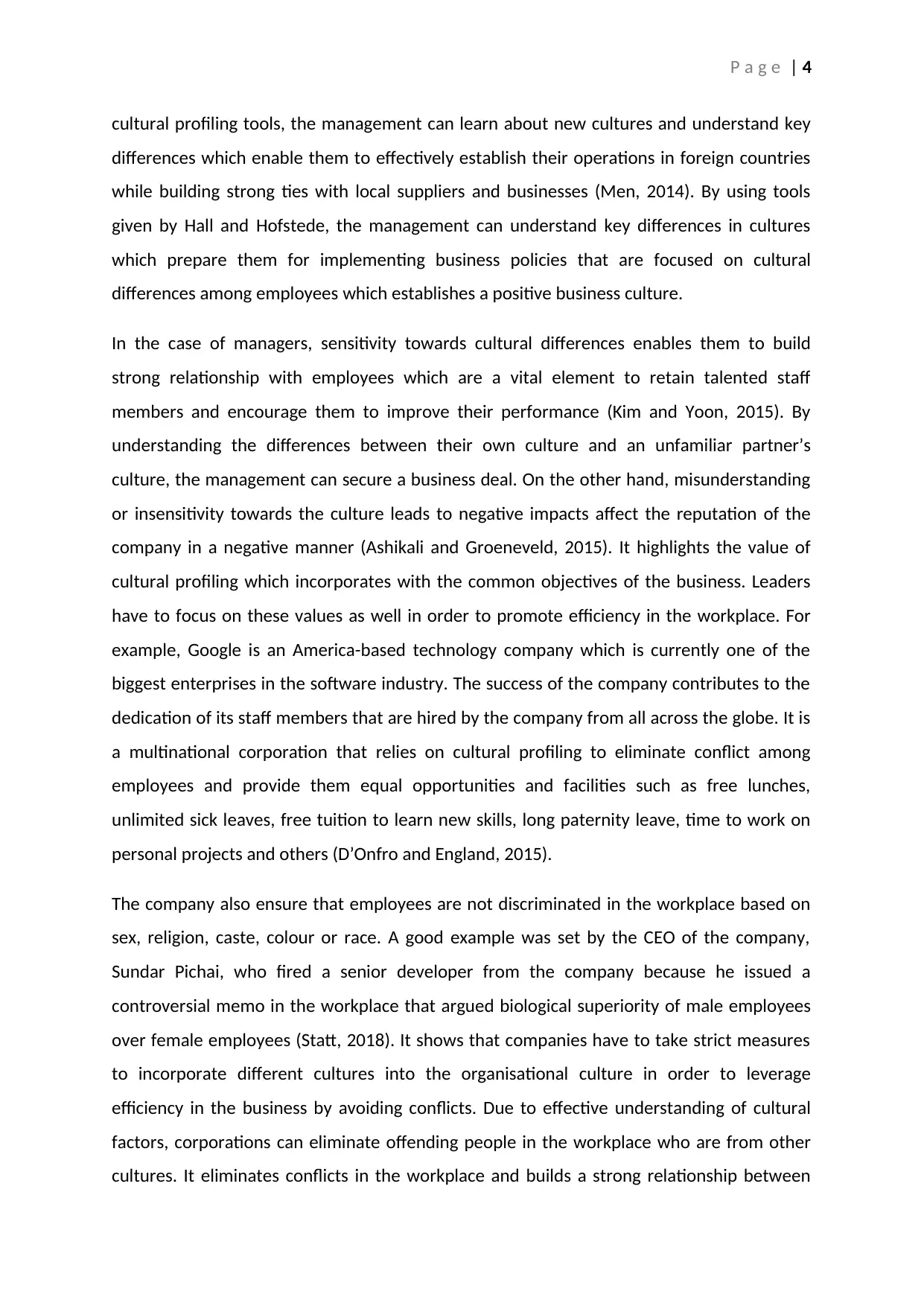
P a g e | 4
cultural profiling tools, the management can learn about new cultures and understand key
differences which enable them to effectively establish their operations in foreign countries
while building strong ties with local suppliers and businesses (Men, 2014). By using tools
given by Hall and Hofstede, the management can understand key differences in cultures
which prepare them for implementing business policies that are focused on cultural
differences among employees which establishes a positive business culture.
In the case of managers, sensitivity towards cultural differences enables them to build
strong relationship with employees which are a vital element to retain talented staff
members and encourage them to improve their performance (Kim and Yoon, 2015). By
understanding the differences between their own culture and an unfamiliar partner’s
culture, the management can secure a business deal. On the other hand, misunderstanding
or insensitivity towards the culture leads to negative impacts affect the reputation of the
company in a negative manner (Ashikali and Groeneveld, 2015). It highlights the value of
cultural profiling which incorporates with the common objectives of the business. Leaders
have to focus on these values as well in order to promote efficiency in the workplace. For
example, Google is an America-based technology company which is currently one of the
biggest enterprises in the software industry. The success of the company contributes to the
dedication of its staff members that are hired by the company from all across the globe. It is
a multinational corporation that relies on cultural profiling to eliminate conflict among
employees and provide them equal opportunities and facilities such as free lunches,
unlimited sick leaves, free tuition to learn new skills, long paternity leave, time to work on
personal projects and others (D’Onfro and England, 2015).
The company also ensure that employees are not discriminated in the workplace based on
sex, religion, caste, colour or race. A good example was set by the CEO of the company,
Sundar Pichai, who fired a senior developer from the company because he issued a
controversial memo in the workplace that argued biological superiority of male employees
over female employees (Statt, 2018). It shows that companies have to take strict measures
to incorporate different cultures into the organisational culture in order to leverage
efficiency in the business by avoiding conflicts. Due to effective understanding of cultural
factors, corporations can eliminate offending people in the workplace who are from other
cultures. It eliminates conflicts in the workplace and builds a strong relationship between
cultural profiling tools, the management can learn about new cultures and understand key
differences which enable them to effectively establish their operations in foreign countries
while building strong ties with local suppliers and businesses (Men, 2014). By using tools
given by Hall and Hofstede, the management can understand key differences in cultures
which prepare them for implementing business policies that are focused on cultural
differences among employees which establishes a positive business culture.
In the case of managers, sensitivity towards cultural differences enables them to build
strong relationship with employees which are a vital element to retain talented staff
members and encourage them to improve their performance (Kim and Yoon, 2015). By
understanding the differences between their own culture and an unfamiliar partner’s
culture, the management can secure a business deal. On the other hand, misunderstanding
or insensitivity towards the culture leads to negative impacts affect the reputation of the
company in a negative manner (Ashikali and Groeneveld, 2015). It highlights the value of
cultural profiling which incorporates with the common objectives of the business. Leaders
have to focus on these values as well in order to promote efficiency in the workplace. For
example, Google is an America-based technology company which is currently one of the
biggest enterprises in the software industry. The success of the company contributes to the
dedication of its staff members that are hired by the company from all across the globe. It is
a multinational corporation that relies on cultural profiling to eliminate conflict among
employees and provide them equal opportunities and facilities such as free lunches,
unlimited sick leaves, free tuition to learn new skills, long paternity leave, time to work on
personal projects and others (D’Onfro and England, 2015).
The company also ensure that employees are not discriminated in the workplace based on
sex, religion, caste, colour or race. A good example was set by the CEO of the company,
Sundar Pichai, who fired a senior developer from the company because he issued a
controversial memo in the workplace that argued biological superiority of male employees
over female employees (Statt, 2018). It shows that companies have to take strict measures
to incorporate different cultures into the organisational culture in order to leverage
efficiency in the business by avoiding conflicts. Due to effective understanding of cultural
factors, corporations can eliminate offending people in the workplace who are from other
cultures. It eliminates conflicts in the workplace and builds a strong relationship between
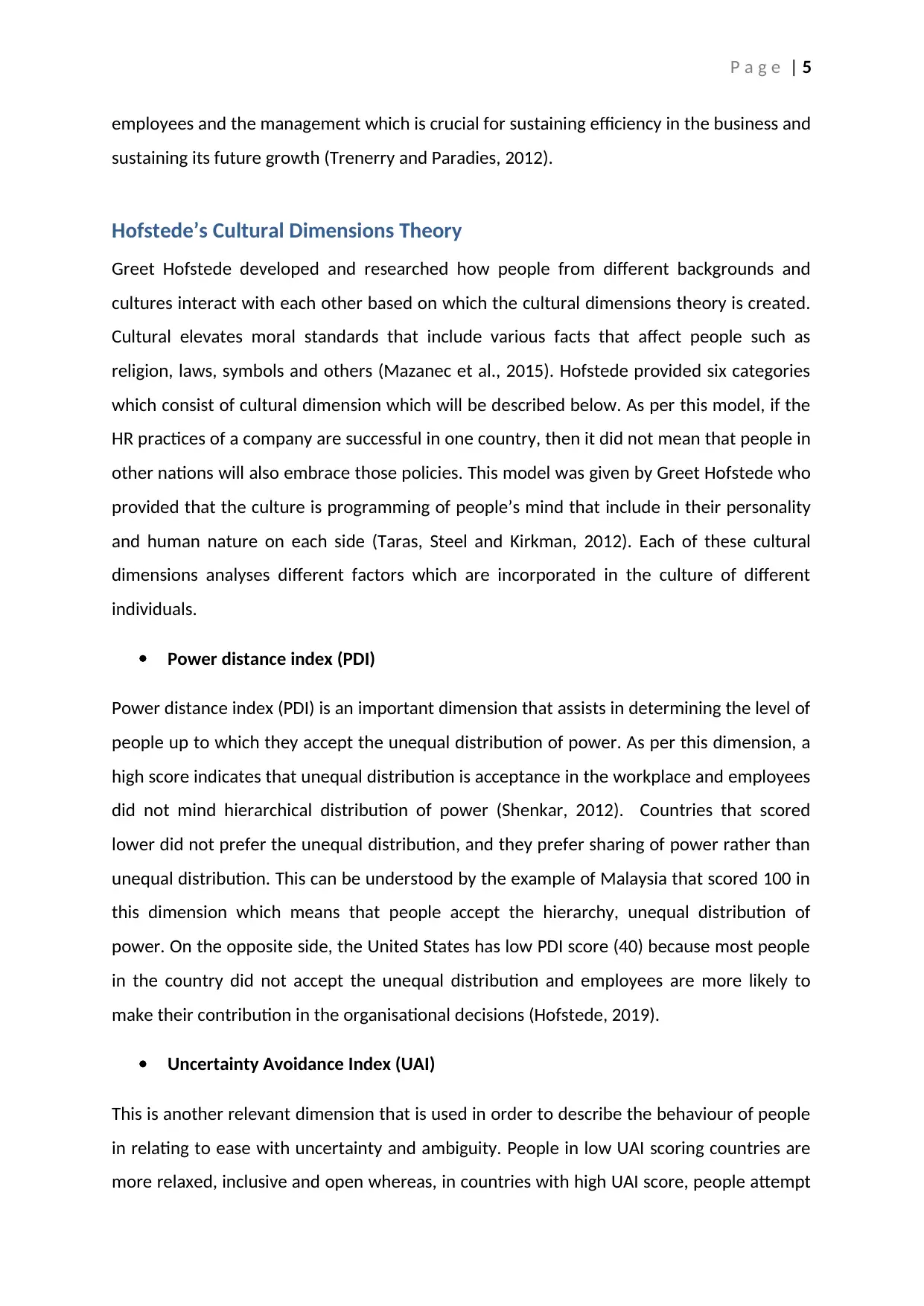
P a g e | 5
employees and the management which is crucial for sustaining efficiency in the business and
sustaining its future growth (Trenerry and Paradies, 2012).
Hofstede’s Cultural Dimensions Theory
Greet Hofstede developed and researched how people from different backgrounds and
cultures interact with each other based on which the cultural dimensions theory is created.
Cultural elevates moral standards that include various facts that affect people such as
religion, laws, symbols and others (Mazanec et al., 2015). Hofstede provided six categories
which consist of cultural dimension which will be described below. As per this model, if the
HR practices of a company are successful in one country, then it did not mean that people in
other nations will also embrace those policies. This model was given by Greet Hofstede who
provided that the culture is programming of people’s mind that include in their personality
and human nature on each side (Taras, Steel and Kirkman, 2012). Each of these cultural
dimensions analyses different factors which are incorporated in the culture of different
individuals.
Power distance index (PDI)
Power distance index (PDI) is an important dimension that assists in determining the level of
people up to which they accept the unequal distribution of power. As per this dimension, a
high score indicates that unequal distribution is acceptance in the workplace and employees
did not mind hierarchical distribution of power (Shenkar, 2012). Countries that scored
lower did not prefer the unequal distribution, and they prefer sharing of power rather than
unequal distribution. This can be understood by the example of Malaysia that scored 100 in
this dimension which means that people accept the hierarchy, unequal distribution of
power. On the opposite side, the United States has low PDI score (40) because most people
in the country did not accept the unequal distribution and employees are more likely to
make their contribution in the organisational decisions (Hofstede, 2019).
Uncertainty Avoidance Index (UAI)
This is another relevant dimension that is used in order to describe the behaviour of people
in relating to ease with uncertainty and ambiguity. People in low UAI scoring countries are
more relaxed, inclusive and open whereas, in countries with high UAI score, people attempt
employees and the management which is crucial for sustaining efficiency in the business and
sustaining its future growth (Trenerry and Paradies, 2012).
Hofstede’s Cultural Dimensions Theory
Greet Hofstede developed and researched how people from different backgrounds and
cultures interact with each other based on which the cultural dimensions theory is created.
Cultural elevates moral standards that include various facts that affect people such as
religion, laws, symbols and others (Mazanec et al., 2015). Hofstede provided six categories
which consist of cultural dimension which will be described below. As per this model, if the
HR practices of a company are successful in one country, then it did not mean that people in
other nations will also embrace those policies. This model was given by Greet Hofstede who
provided that the culture is programming of people’s mind that include in their personality
and human nature on each side (Taras, Steel and Kirkman, 2012). Each of these cultural
dimensions analyses different factors which are incorporated in the culture of different
individuals.
Power distance index (PDI)
Power distance index (PDI) is an important dimension that assists in determining the level of
people up to which they accept the unequal distribution of power. As per this dimension, a
high score indicates that unequal distribution is acceptance in the workplace and employees
did not mind hierarchical distribution of power (Shenkar, 2012). Countries that scored
lower did not prefer the unequal distribution, and they prefer sharing of power rather than
unequal distribution. This can be understood by the example of Malaysia that scored 100 in
this dimension which means that people accept the hierarchy, unequal distribution of
power. On the opposite side, the United States has low PDI score (40) because most people
in the country did not accept the unequal distribution and employees are more likely to
make their contribution in the organisational decisions (Hofstede, 2019).
Uncertainty Avoidance Index (UAI)
This is another relevant dimension that is used in order to describe the behaviour of people
in relating to ease with uncertainty and ambiguity. People in low UAI scoring countries are
more relaxed, inclusive and open whereas, in countries with high UAI score, people attempt
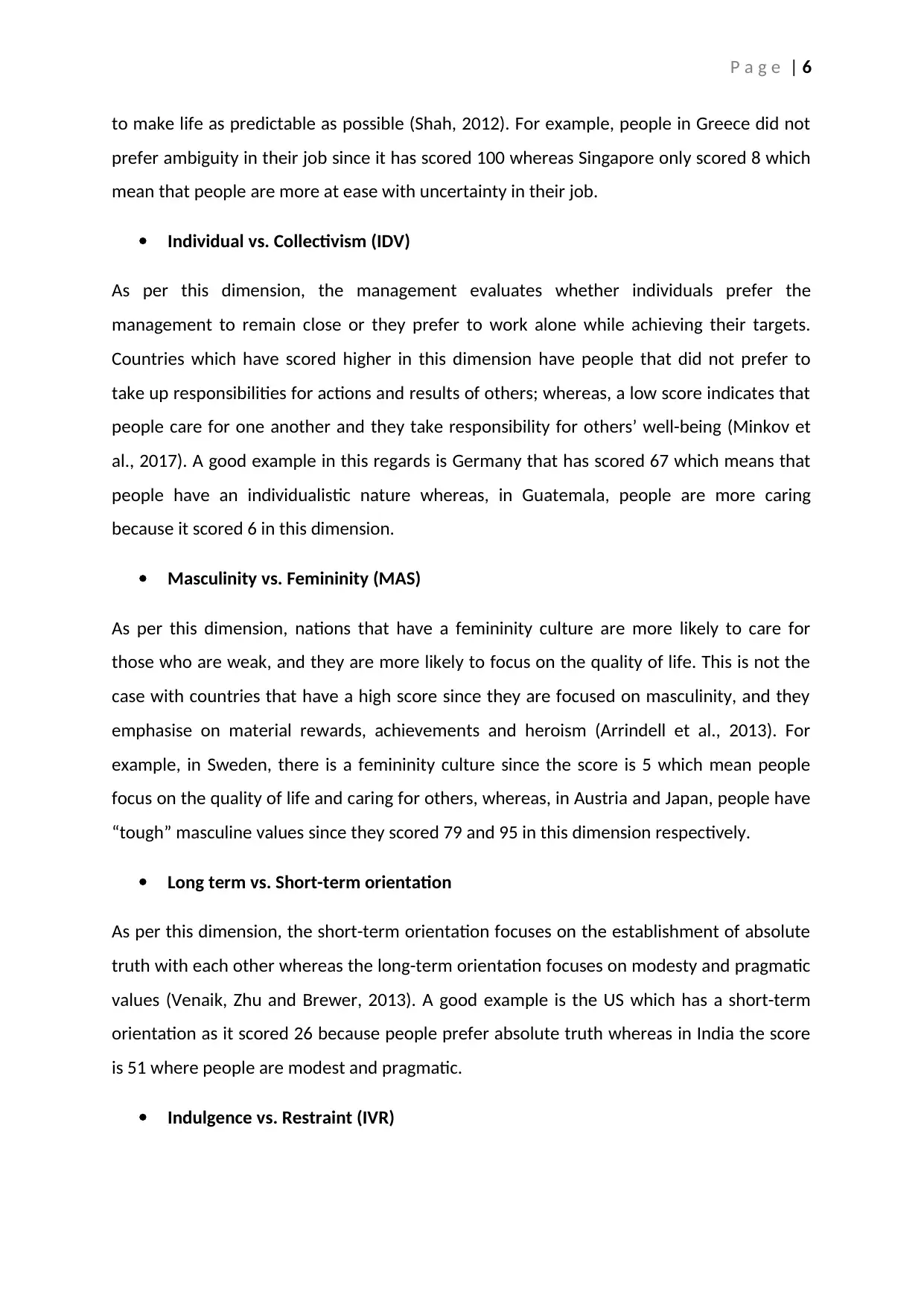
P a g e | 6
to make life as predictable as possible (Shah, 2012). For example, people in Greece did not
prefer ambiguity in their job since it has scored 100 whereas Singapore only scored 8 which
mean that people are more at ease with uncertainty in their job.
Individual vs. Collectivism (IDV)
As per this dimension, the management evaluates whether individuals prefer the
management to remain close or they prefer to work alone while achieving their targets.
Countries which have scored higher in this dimension have people that did not prefer to
take up responsibilities for actions and results of others; whereas, a low score indicates that
people care for one another and they take responsibility for others’ well-being (Minkov et
al., 2017). A good example in this regards is Germany that has scored 67 which means that
people have an individualistic nature whereas, in Guatemala, people are more caring
because it scored 6 in this dimension.
Masculinity vs. Femininity (MAS)
As per this dimension, nations that have a femininity culture are more likely to care for
those who are weak, and they are more likely to focus on the quality of life. This is not the
case with countries that have a high score since they are focused on masculinity, and they
emphasise on material rewards, achievements and heroism (Arrindell et al., 2013). For
example, in Sweden, there is a femininity culture since the score is 5 which mean people
focus on the quality of life and caring for others, whereas, in Austria and Japan, people have
“tough” masculine values since they scored 79 and 95 in this dimension respectively.
Long term vs. Short-term orientation
As per this dimension, the short-term orientation focuses on the establishment of absolute
truth with each other whereas the long-term orientation focuses on modesty and pragmatic
values (Venaik, Zhu and Brewer, 2013). A good example is the US which has a short-term
orientation as it scored 26 because people prefer absolute truth whereas in India the score
is 51 where people are modest and pragmatic.
Indulgence vs. Restraint (IVR)
to make life as predictable as possible (Shah, 2012). For example, people in Greece did not
prefer ambiguity in their job since it has scored 100 whereas Singapore only scored 8 which
mean that people are more at ease with uncertainty in their job.
Individual vs. Collectivism (IDV)
As per this dimension, the management evaluates whether individuals prefer the
management to remain close or they prefer to work alone while achieving their targets.
Countries which have scored higher in this dimension have people that did not prefer to
take up responsibilities for actions and results of others; whereas, a low score indicates that
people care for one another and they take responsibility for others’ well-being (Minkov et
al., 2017). A good example in this regards is Germany that has scored 67 which means that
people have an individualistic nature whereas, in Guatemala, people are more caring
because it scored 6 in this dimension.
Masculinity vs. Femininity (MAS)
As per this dimension, nations that have a femininity culture are more likely to care for
those who are weak, and they are more likely to focus on the quality of life. This is not the
case with countries that have a high score since they are focused on masculinity, and they
emphasise on material rewards, achievements and heroism (Arrindell et al., 2013). For
example, in Sweden, there is a femininity culture since the score is 5 which mean people
focus on the quality of life and caring for others, whereas, in Austria and Japan, people have
“tough” masculine values since they scored 79 and 95 in this dimension respectively.
Long term vs. Short-term orientation
As per this dimension, the short-term orientation focuses on the establishment of absolute
truth with each other whereas the long-term orientation focuses on modesty and pragmatic
values (Venaik, Zhu and Brewer, 2013). A good example is the US which has a short-term
orientation as it scored 26 because people prefer absolute truth whereas in India the score
is 51 where people are modest and pragmatic.
Indulgence vs. Restraint (IVR)
Paraphrase This Document
Need a fresh take? Get an instant paraphrase of this document with our AI Paraphraser
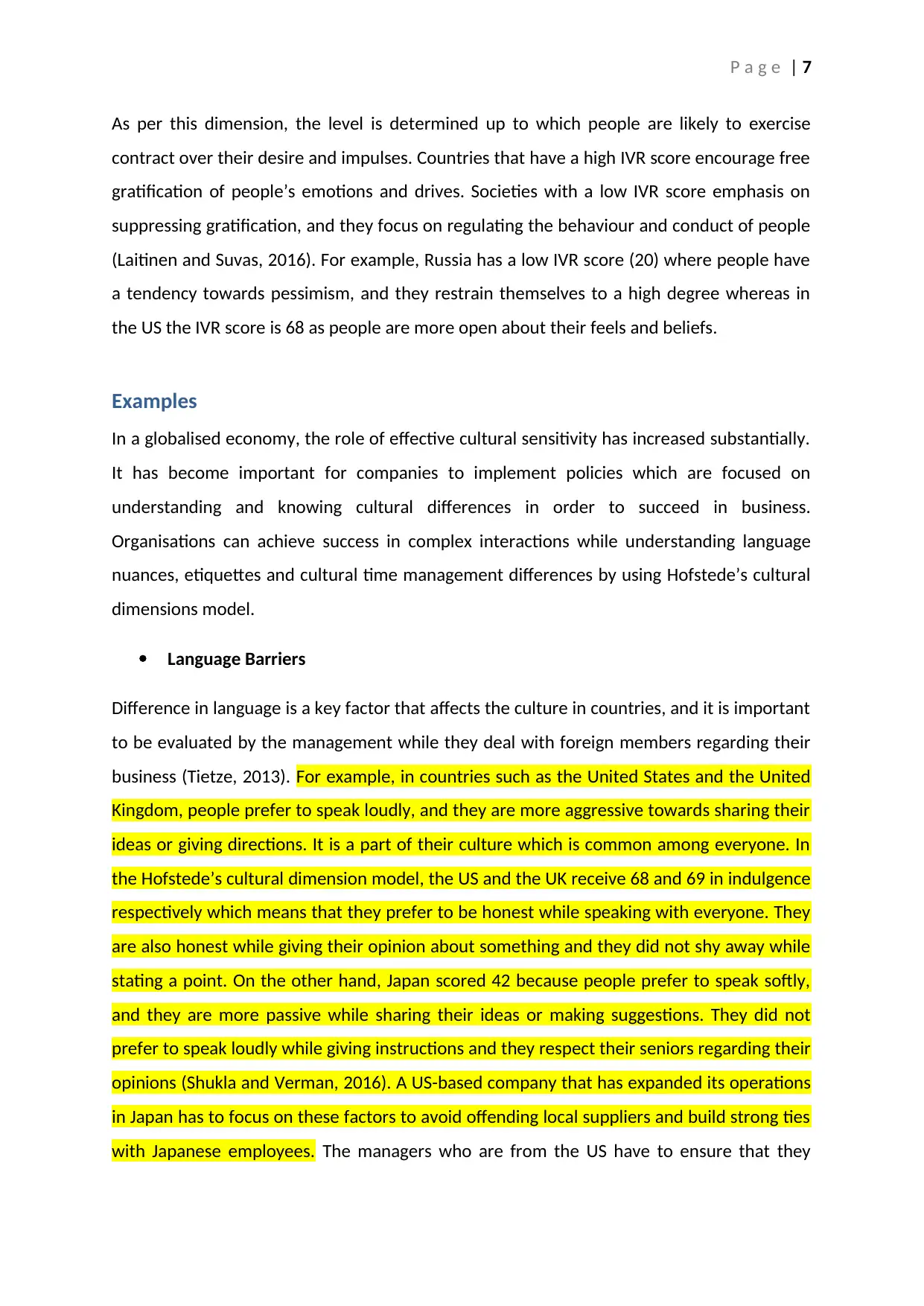
P a g e | 7
As per this dimension, the level is determined up to which people are likely to exercise
contract over their desire and impulses. Countries that have a high IVR score encourage free
gratification of people’s emotions and drives. Societies with a low IVR score emphasis on
suppressing gratification, and they focus on regulating the behaviour and conduct of people
(Laitinen and Suvas, 2016). For example, Russia has a low IVR score (20) where people have
a tendency towards pessimism, and they restrain themselves to a high degree whereas in
the US the IVR score is 68 as people are more open about their feels and beliefs.
Examples
In a globalised economy, the role of effective cultural sensitivity has increased substantially.
It has become important for companies to implement policies which are focused on
understanding and knowing cultural differences in order to succeed in business.
Organisations can achieve success in complex interactions while understanding language
nuances, etiquettes and cultural time management differences by using Hofstede’s cultural
dimensions model.
Language Barriers
Difference in language is a key factor that affects the culture in countries, and it is important
to be evaluated by the management while they deal with foreign members regarding their
business (Tietze, 2013). For example, in countries such as the United States and the United
Kingdom, people prefer to speak loudly, and they are more aggressive towards sharing their
ideas or giving directions. It is a part of their culture which is common among everyone. In
the Hofstede’s cultural dimension model, the US and the UK receive 68 and 69 in indulgence
respectively which means that they prefer to be honest while speaking with everyone. They
are also honest while giving their opinion about something and they did not shy away while
stating a point. On the other hand, Japan scored 42 because people prefer to speak softly,
and they are more passive while sharing their ideas or making suggestions. They did not
prefer to speak loudly while giving instructions and they respect their seniors regarding their
opinions (Shukla and Verman, 2016). A US-based company that has expanded its operations
in Japan has to focus on these factors to avoid offending local suppliers and build strong ties
with Japanese employees. The managers who are from the US have to ensure that they
As per this dimension, the level is determined up to which people are likely to exercise
contract over their desire and impulses. Countries that have a high IVR score encourage free
gratification of people’s emotions and drives. Societies with a low IVR score emphasis on
suppressing gratification, and they focus on regulating the behaviour and conduct of people
(Laitinen and Suvas, 2016). For example, Russia has a low IVR score (20) where people have
a tendency towards pessimism, and they restrain themselves to a high degree whereas in
the US the IVR score is 68 as people are more open about their feels and beliefs.
Examples
In a globalised economy, the role of effective cultural sensitivity has increased substantially.
It has become important for companies to implement policies which are focused on
understanding and knowing cultural differences in order to succeed in business.
Organisations can achieve success in complex interactions while understanding language
nuances, etiquettes and cultural time management differences by using Hofstede’s cultural
dimensions model.
Language Barriers
Difference in language is a key factor that affects the culture in countries, and it is important
to be evaluated by the management while they deal with foreign members regarding their
business (Tietze, 2013). For example, in countries such as the United States and the United
Kingdom, people prefer to speak loudly, and they are more aggressive towards sharing their
ideas or giving directions. It is a part of their culture which is common among everyone. In
the Hofstede’s cultural dimension model, the US and the UK receive 68 and 69 in indulgence
respectively which means that they prefer to be honest while speaking with everyone. They
are also honest while giving their opinion about something and they did not shy away while
stating a point. On the other hand, Japan scored 42 because people prefer to speak softly,
and they are more passive while sharing their ideas or making suggestions. They did not
prefer to speak loudly while giving instructions and they respect their seniors regarding their
opinions (Shukla and Verman, 2016). A US-based company that has expanded its operations
in Japan has to focus on these factors to avoid offending local suppliers and build strong ties
with Japanese employees. The managers who are from the US have to ensure that they
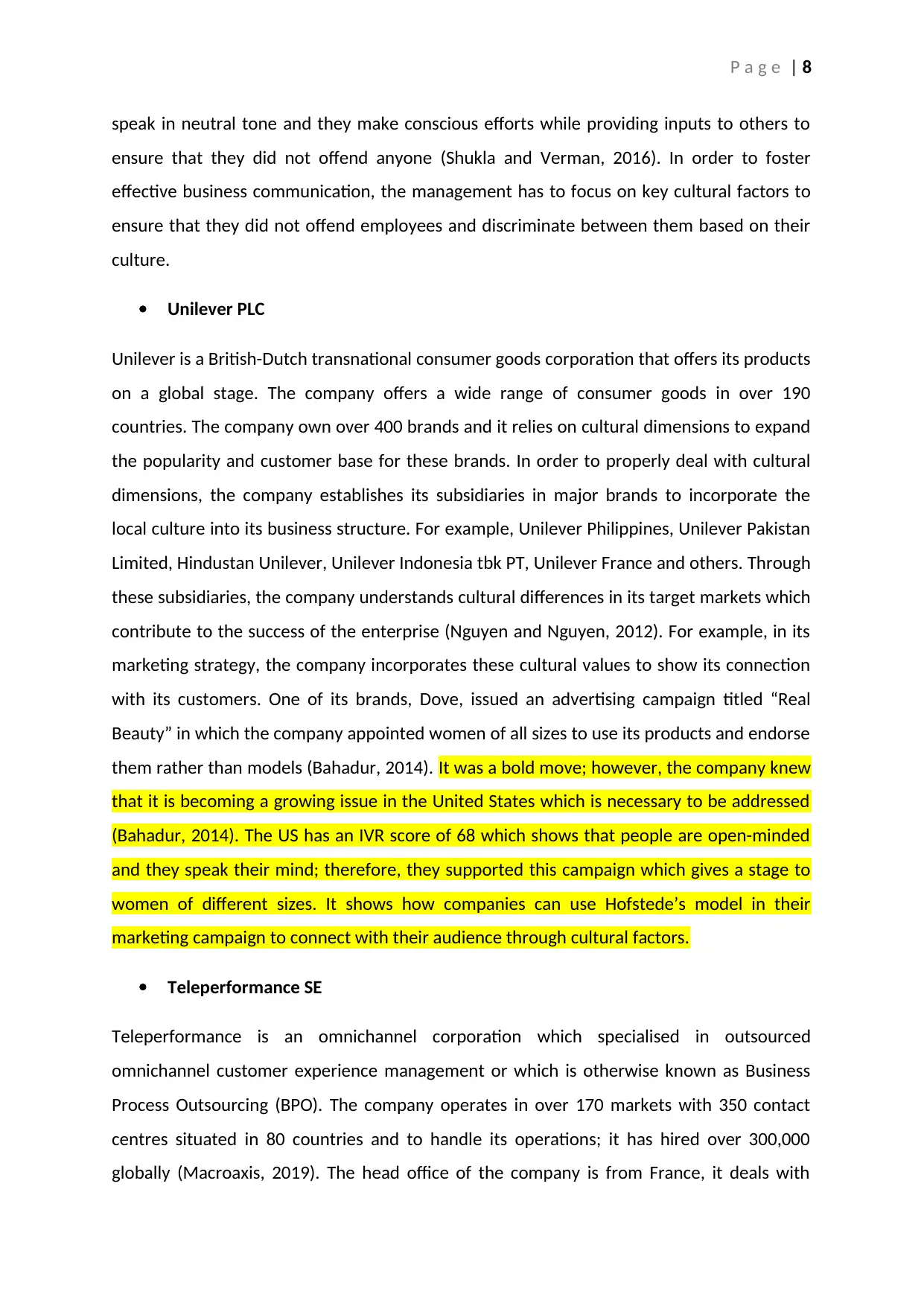
P a g e | 8
speak in neutral tone and they make conscious efforts while providing inputs to others to
ensure that they did not offend anyone (Shukla and Verman, 2016). In order to foster
effective business communication, the management has to focus on key cultural factors to
ensure that they did not offend employees and discriminate between them based on their
culture.
Unilever PLC
Unilever is a British-Dutch transnational consumer goods corporation that offers its products
on a global stage. The company offers a wide range of consumer goods in over 190
countries. The company own over 400 brands and it relies on cultural dimensions to expand
the popularity and customer base for these brands. In order to properly deal with cultural
dimensions, the company establishes its subsidiaries in major brands to incorporate the
local culture into its business structure. For example, Unilever Philippines, Unilever Pakistan
Limited, Hindustan Unilever, Unilever Indonesia tbk PT, Unilever France and others. Through
these subsidiaries, the company understands cultural differences in its target markets which
contribute to the success of the enterprise (Nguyen and Nguyen, 2012). For example, in its
marketing strategy, the company incorporates these cultural values to show its connection
with its customers. One of its brands, Dove, issued an advertising campaign titled “Real
Beauty” in which the company appointed women of all sizes to use its products and endorse
them rather than models (Bahadur, 2014). It was a bold move; however, the company knew
that it is becoming a growing issue in the United States which is necessary to be addressed
(Bahadur, 2014). The US has an IVR score of 68 which shows that people are open-minded
and they speak their mind; therefore, they supported this campaign which gives a stage to
women of different sizes. It shows how companies can use Hofstede’s model in their
marketing campaign to connect with their audience through cultural factors.
Teleperformance SE
Teleperformance is an omnichannel corporation which specialised in outsourced
omnichannel customer experience management or which is otherwise known as Business
Process Outsourcing (BPO). The company operates in over 170 markets with 350 contact
centres situated in 80 countries and to handle its operations; it has hired over 300,000
globally (Macroaxis, 2019). The head office of the company is from France, it deals with
speak in neutral tone and they make conscious efforts while providing inputs to others to
ensure that they did not offend anyone (Shukla and Verman, 2016). In order to foster
effective business communication, the management has to focus on key cultural factors to
ensure that they did not offend employees and discriminate between them based on their
culture.
Unilever PLC
Unilever is a British-Dutch transnational consumer goods corporation that offers its products
on a global stage. The company offers a wide range of consumer goods in over 190
countries. The company own over 400 brands and it relies on cultural dimensions to expand
the popularity and customer base for these brands. In order to properly deal with cultural
dimensions, the company establishes its subsidiaries in major brands to incorporate the
local culture into its business structure. For example, Unilever Philippines, Unilever Pakistan
Limited, Hindustan Unilever, Unilever Indonesia tbk PT, Unilever France and others. Through
these subsidiaries, the company understands cultural differences in its target markets which
contribute to the success of the enterprise (Nguyen and Nguyen, 2012). For example, in its
marketing strategy, the company incorporates these cultural values to show its connection
with its customers. One of its brands, Dove, issued an advertising campaign titled “Real
Beauty” in which the company appointed women of all sizes to use its products and endorse
them rather than models (Bahadur, 2014). It was a bold move; however, the company knew
that it is becoming a growing issue in the United States which is necessary to be addressed
(Bahadur, 2014). The US has an IVR score of 68 which shows that people are open-minded
and they speak their mind; therefore, they supported this campaign which gives a stage to
women of different sizes. It shows how companies can use Hofstede’s model in their
marketing campaign to connect with their audience through cultural factors.
Teleperformance SE
Teleperformance is an omnichannel corporation which specialised in outsourced
omnichannel customer experience management or which is otherwise known as Business
Process Outsourcing (BPO). The company operates in over 170 markets with 350 contact
centres situated in 80 countries and to handle its operations; it has hired over 300,000
globally (Macroaxis, 2019). The head office of the company is from France, it deals with
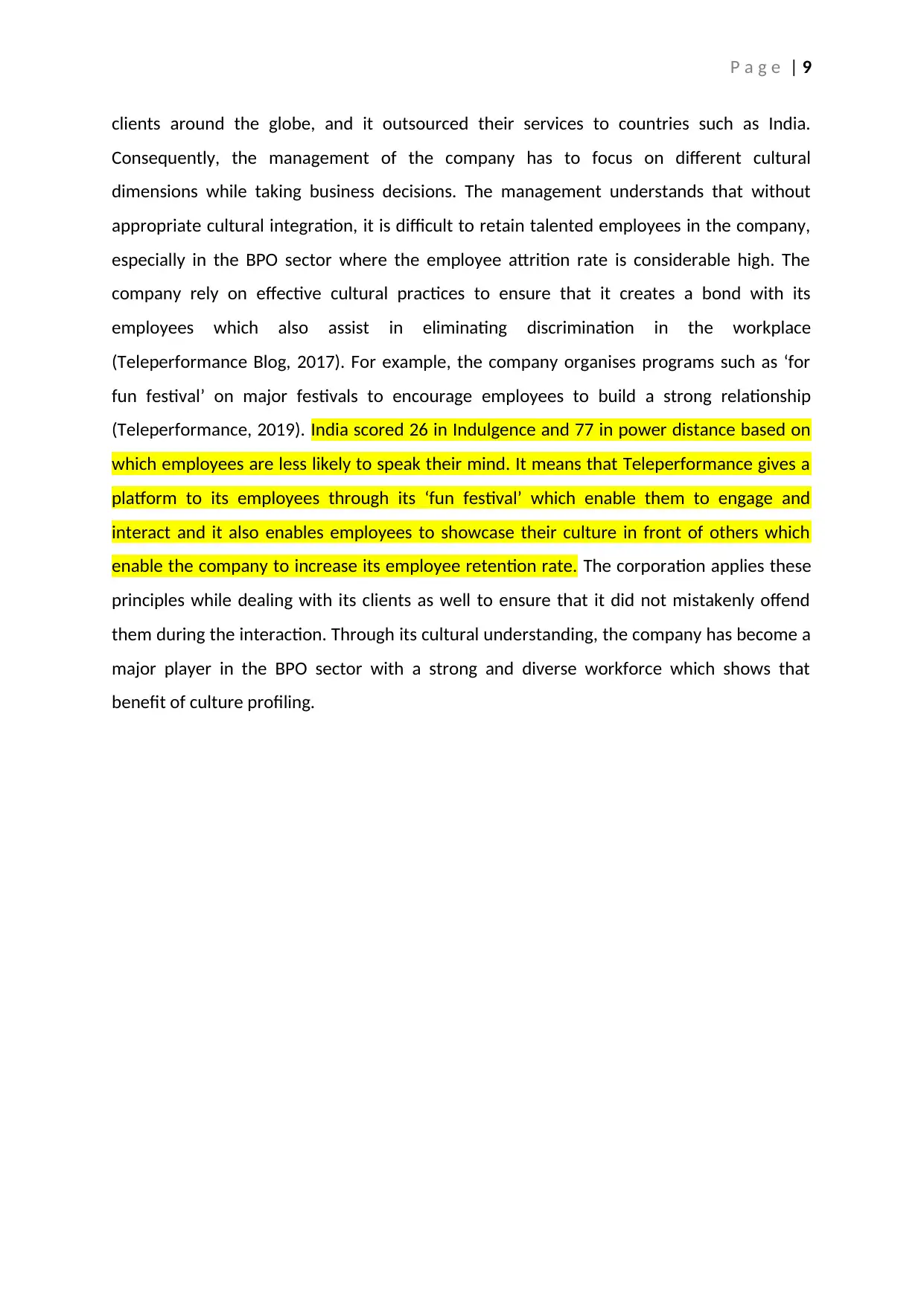
P a g e | 9
clients around the globe, and it outsourced their services to countries such as India.
Consequently, the management of the company has to focus on different cultural
dimensions while taking business decisions. The management understands that without
appropriate cultural integration, it is difficult to retain talented employees in the company,
especially in the BPO sector where the employee attrition rate is considerable high. The
company rely on effective cultural practices to ensure that it creates a bond with its
employees which also assist in eliminating discrimination in the workplace
(Teleperformance Blog, 2017). For example, the company organises programs such as ‘for
fun festival’ on major festivals to encourage employees to build a strong relationship
(Teleperformance, 2019). India scored 26 in Indulgence and 77 in power distance based on
which employees are less likely to speak their mind. It means that Teleperformance gives a
platform to its employees through its ‘fun festival’ which enable them to engage and
interact and it also enables employees to showcase their culture in front of others which
enable the company to increase its employee retention rate. The corporation applies these
principles while dealing with its clients as well to ensure that it did not mistakenly offend
them during the interaction. Through its cultural understanding, the company has become a
major player in the BPO sector with a strong and diverse workforce which shows that
benefit of culture profiling.
clients around the globe, and it outsourced their services to countries such as India.
Consequently, the management of the company has to focus on different cultural
dimensions while taking business decisions. The management understands that without
appropriate cultural integration, it is difficult to retain talented employees in the company,
especially in the BPO sector where the employee attrition rate is considerable high. The
company rely on effective cultural practices to ensure that it creates a bond with its
employees which also assist in eliminating discrimination in the workplace
(Teleperformance Blog, 2017). For example, the company organises programs such as ‘for
fun festival’ on major festivals to encourage employees to build a strong relationship
(Teleperformance, 2019). India scored 26 in Indulgence and 77 in power distance based on
which employees are less likely to speak their mind. It means that Teleperformance gives a
platform to its employees through its ‘fun festival’ which enable them to engage and
interact and it also enables employees to showcase their culture in front of others which
enable the company to increase its employee retention rate. The corporation applies these
principles while dealing with its clients as well to ensure that it did not mistakenly offend
them during the interaction. Through its cultural understanding, the company has become a
major player in the BPO sector with a strong and diverse workforce which shows that
benefit of culture profiling.
Secure Best Marks with AI Grader
Need help grading? Try our AI Grader for instant feedback on your assignments.
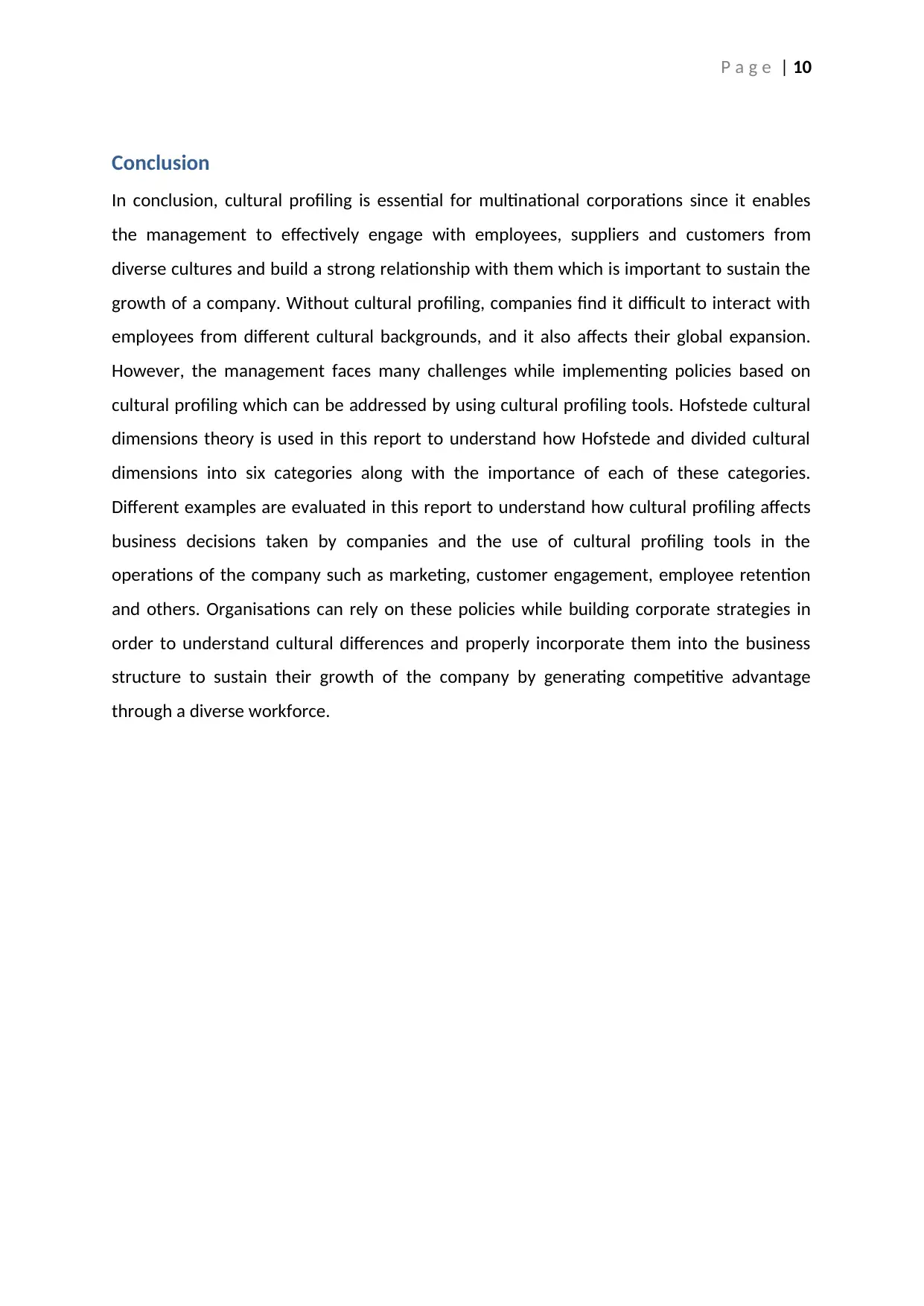
P a g e | 10
Conclusion
In conclusion, cultural profiling is essential for multinational corporations since it enables
the management to effectively engage with employees, suppliers and customers from
diverse cultures and build a strong relationship with them which is important to sustain the
growth of a company. Without cultural profiling, companies find it difficult to interact with
employees from different cultural backgrounds, and it also affects their global expansion.
However, the management faces many challenges while implementing policies based on
cultural profiling which can be addressed by using cultural profiling tools. Hofstede cultural
dimensions theory is used in this report to understand how Hofstede and divided cultural
dimensions into six categories along with the importance of each of these categories.
Different examples are evaluated in this report to understand how cultural profiling affects
business decisions taken by companies and the use of cultural profiling tools in the
operations of the company such as marketing, customer engagement, employee retention
and others. Organisations can rely on these policies while building corporate strategies in
order to understand cultural differences and properly incorporate them into the business
structure to sustain their growth of the company by generating competitive advantage
through a diverse workforce.
Conclusion
In conclusion, cultural profiling is essential for multinational corporations since it enables
the management to effectively engage with employees, suppliers and customers from
diverse cultures and build a strong relationship with them which is important to sustain the
growth of a company. Without cultural profiling, companies find it difficult to interact with
employees from different cultural backgrounds, and it also affects their global expansion.
However, the management faces many challenges while implementing policies based on
cultural profiling which can be addressed by using cultural profiling tools. Hofstede cultural
dimensions theory is used in this report to understand how Hofstede and divided cultural
dimensions into six categories along with the importance of each of these categories.
Different examples are evaluated in this report to understand how cultural profiling affects
business decisions taken by companies and the use of cultural profiling tools in the
operations of the company such as marketing, customer engagement, employee retention
and others. Organisations can rely on these policies while building corporate strategies in
order to understand cultural differences and properly incorporate them into the business
structure to sustain their growth of the company by generating competitive advantage
through a diverse workforce.
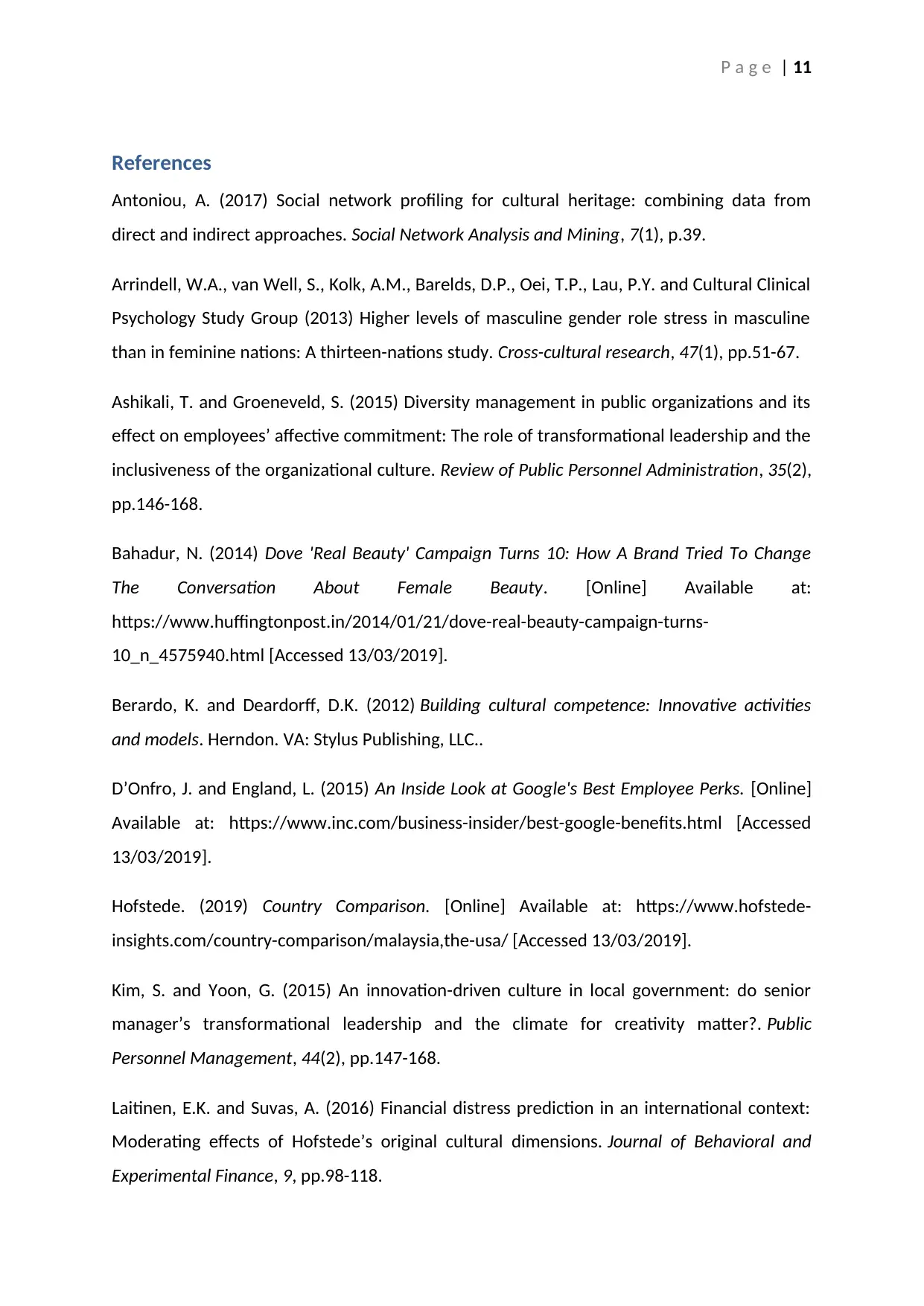
P a g e | 11
References
Antoniou, A. (2017) Social network profiling for cultural heritage: combining data from
direct and indirect approaches. Social Network Analysis and Mining, 7(1), p.39.
Arrindell, W.A., van Well, S., Kolk, A.M., Barelds, D.P., Oei, T.P., Lau, P.Y. and Cultural Clinical
Psychology Study Group (2013) Higher levels of masculine gender role stress in masculine
than in feminine nations: A thirteen-nations study. Cross-cultural research, 47(1), pp.51-67.
Ashikali, T. and Groeneveld, S. (2015) Diversity management in public organizations and its
effect on employees’ affective commitment: The role of transformational leadership and the
inclusiveness of the organizational culture. Review of Public Personnel Administration, 35(2),
pp.146-168.
Bahadur, N. (2014) Dove 'Real Beauty' Campaign Turns 10: How A Brand Tried To Change
The Conversation About Female Beauty. [Online] Available at:
https://www.huffingtonpost.in/2014/01/21/dove-real-beauty-campaign-turns-
10_n_4575940.html [Accessed 13/03/2019].
Berardo, K. and Deardorff, D.K. (2012) Building cultural competence: Innovative activities
and models. Herndon. VA: Stylus Publishing, LLC..
D’Onfro, J. and England, L. (2015) An Inside Look at Google's Best Employee Perks. [Online]
Available at: https://www.inc.com/business-insider/best-google-benefits.html [Accessed
13/03/2019].
Hofstede. (2019) Country Comparison. [Online] Available at: https://www.hofstede-
insights.com/country-comparison/malaysia,the-usa/ [Accessed 13/03/2019].
Kim, S. and Yoon, G. (2015) An innovation-driven culture in local government: do senior
manager’s transformational leadership and the climate for creativity matter?. Public
Personnel Management, 44(2), pp.147-168.
Laitinen, E.K. and Suvas, A. (2016) Financial distress prediction in an international context:
Moderating effects of Hofstede’s original cultural dimensions. Journal of Behavioral and
Experimental Finance, 9, pp.98-118.
References
Antoniou, A. (2017) Social network profiling for cultural heritage: combining data from
direct and indirect approaches. Social Network Analysis and Mining, 7(1), p.39.
Arrindell, W.A., van Well, S., Kolk, A.M., Barelds, D.P., Oei, T.P., Lau, P.Y. and Cultural Clinical
Psychology Study Group (2013) Higher levels of masculine gender role stress in masculine
than in feminine nations: A thirteen-nations study. Cross-cultural research, 47(1), pp.51-67.
Ashikali, T. and Groeneveld, S. (2015) Diversity management in public organizations and its
effect on employees’ affective commitment: The role of transformational leadership and the
inclusiveness of the organizational culture. Review of Public Personnel Administration, 35(2),
pp.146-168.
Bahadur, N. (2014) Dove 'Real Beauty' Campaign Turns 10: How A Brand Tried To Change
The Conversation About Female Beauty. [Online] Available at:
https://www.huffingtonpost.in/2014/01/21/dove-real-beauty-campaign-turns-
10_n_4575940.html [Accessed 13/03/2019].
Berardo, K. and Deardorff, D.K. (2012) Building cultural competence: Innovative activities
and models. Herndon. VA: Stylus Publishing, LLC..
D’Onfro, J. and England, L. (2015) An Inside Look at Google's Best Employee Perks. [Online]
Available at: https://www.inc.com/business-insider/best-google-benefits.html [Accessed
13/03/2019].
Hofstede. (2019) Country Comparison. [Online] Available at: https://www.hofstede-
insights.com/country-comparison/malaysia,the-usa/ [Accessed 13/03/2019].
Kim, S. and Yoon, G. (2015) An innovation-driven culture in local government: do senior
manager’s transformational leadership and the climate for creativity matter?. Public
Personnel Management, 44(2), pp.147-168.
Laitinen, E.K. and Suvas, A. (2016) Financial distress prediction in an international context:
Moderating effects of Hofstede’s original cultural dimensions. Journal of Behavioral and
Experimental Finance, 9, pp.98-118.
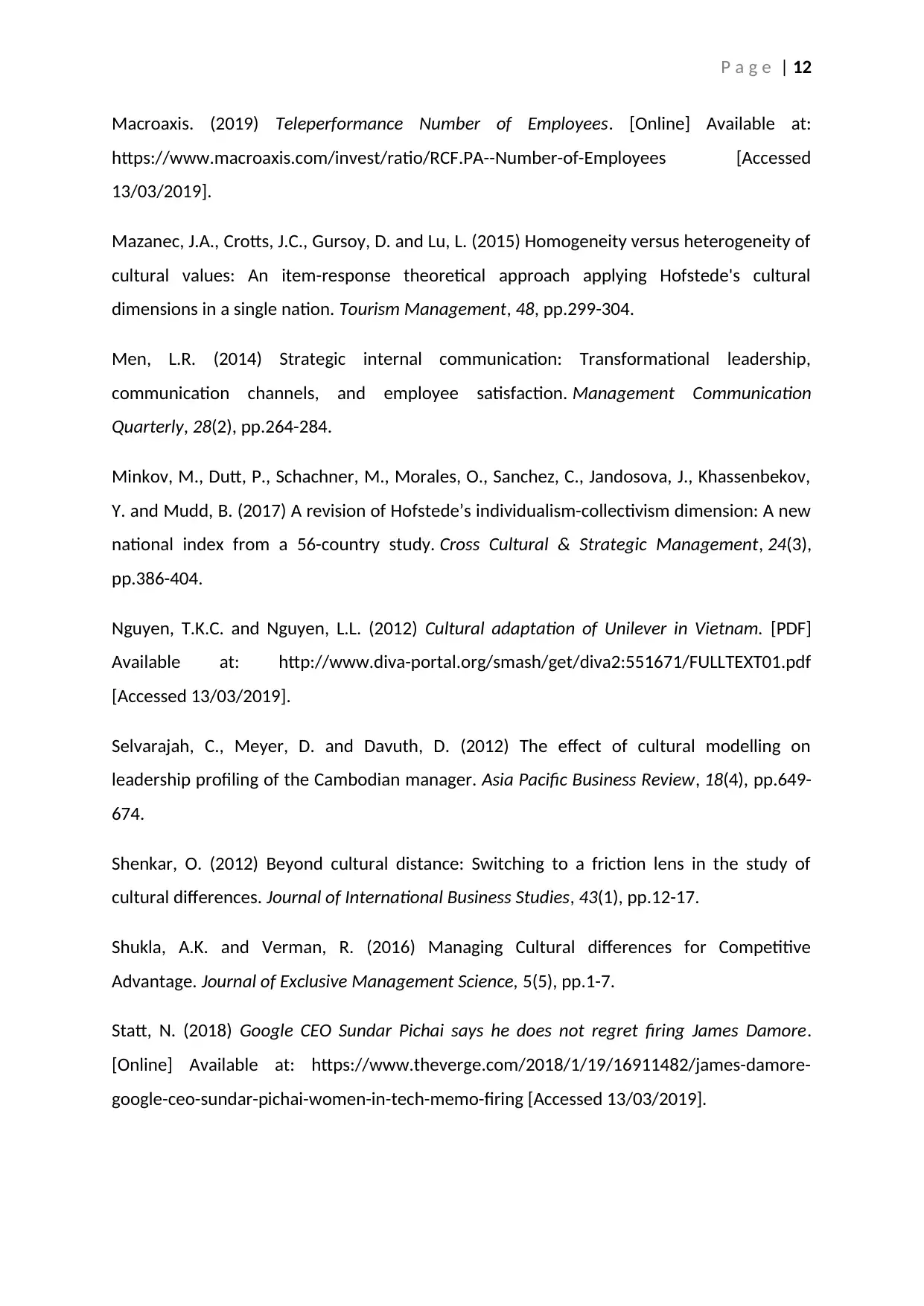
P a g e | 12
Macroaxis. (2019) Teleperformance Number of Employees. [Online] Available at:
https://www.macroaxis.com/invest/ratio/RCF.PA--Number-of-Employees [Accessed
13/03/2019].
Mazanec, J.A., Crotts, J.C., Gursoy, D. and Lu, L. (2015) Homogeneity versus heterogeneity of
cultural values: An item-response theoretical approach applying Hofstede's cultural
dimensions in a single nation. Tourism Management, 48, pp.299-304.
Men, L.R. (2014) Strategic internal communication: Transformational leadership,
communication channels, and employee satisfaction. Management Communication
Quarterly, 28(2), pp.264-284.
Minkov, M., Dutt, P., Schachner, M., Morales, O., Sanchez, C., Jandosova, J., Khassenbekov,
Y. and Mudd, B. (2017) A revision of Hofstede’s individualism-collectivism dimension: A new
national index from a 56-country study. Cross Cultural & Strategic Management, 24(3),
pp.386-404.
Nguyen, T.K.C. and Nguyen, L.L. (2012) Cultural adaptation of Unilever in Vietnam. [PDF]
Available at: http://www.diva-portal.org/smash/get/diva2:551671/FULLTEXT01.pdf
[Accessed 13/03/2019].
Selvarajah, C., Meyer, D. and Davuth, D. (2012) The effect of cultural modelling on
leadership profiling of the Cambodian manager. Asia Pacific Business Review, 18(4), pp.649-
674.
Shenkar, O. (2012) Beyond cultural distance: Switching to a friction lens in the study of
cultural differences. Journal of International Business Studies, 43(1), pp.12-17.
Shukla, A.K. and Verman, R. (2016) Managing Cultural differences for Competitive
Advantage. Journal of Exclusive Management Science, 5(5), pp.1-7.
Statt, N. (2018) Google CEO Sundar Pichai says he does not regret firing James Damore.
[Online] Available at: https://www.theverge.com/2018/1/19/16911482/james-damore-
google-ceo-sundar-pichai-women-in-tech-memo-firing [Accessed 13/03/2019].
Macroaxis. (2019) Teleperformance Number of Employees. [Online] Available at:
https://www.macroaxis.com/invest/ratio/RCF.PA--Number-of-Employees [Accessed
13/03/2019].
Mazanec, J.A., Crotts, J.C., Gursoy, D. and Lu, L. (2015) Homogeneity versus heterogeneity of
cultural values: An item-response theoretical approach applying Hofstede's cultural
dimensions in a single nation. Tourism Management, 48, pp.299-304.
Men, L.R. (2014) Strategic internal communication: Transformational leadership,
communication channels, and employee satisfaction. Management Communication
Quarterly, 28(2), pp.264-284.
Minkov, M., Dutt, P., Schachner, M., Morales, O., Sanchez, C., Jandosova, J., Khassenbekov,
Y. and Mudd, B. (2017) A revision of Hofstede’s individualism-collectivism dimension: A new
national index from a 56-country study. Cross Cultural & Strategic Management, 24(3),
pp.386-404.
Nguyen, T.K.C. and Nguyen, L.L. (2012) Cultural adaptation of Unilever in Vietnam. [PDF]
Available at: http://www.diva-portal.org/smash/get/diva2:551671/FULLTEXT01.pdf
[Accessed 13/03/2019].
Selvarajah, C., Meyer, D. and Davuth, D. (2012) The effect of cultural modelling on
leadership profiling of the Cambodian manager. Asia Pacific Business Review, 18(4), pp.649-
674.
Shenkar, O. (2012) Beyond cultural distance: Switching to a friction lens in the study of
cultural differences. Journal of International Business Studies, 43(1), pp.12-17.
Shukla, A.K. and Verman, R. (2016) Managing Cultural differences for Competitive
Advantage. Journal of Exclusive Management Science, 5(5), pp.1-7.
Statt, N. (2018) Google CEO Sundar Pichai says he does not regret firing James Damore.
[Online] Available at: https://www.theverge.com/2018/1/19/16911482/james-damore-
google-ceo-sundar-pichai-women-in-tech-memo-firing [Accessed 13/03/2019].
Paraphrase This Document
Need a fresh take? Get an instant paraphrase of this document with our AI Paraphraser
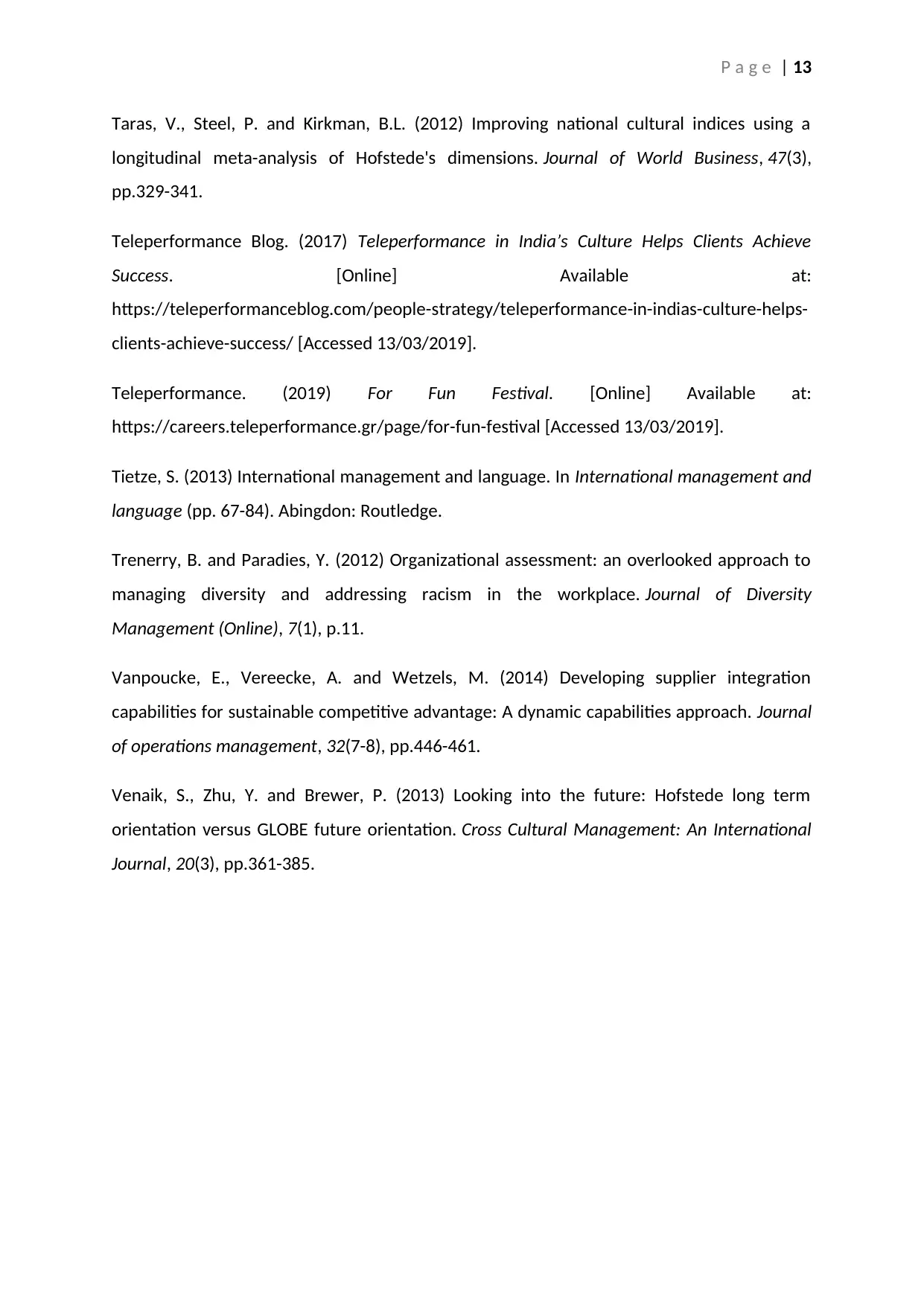
P a g e | 13
Taras, V., Steel, P. and Kirkman, B.L. (2012) Improving national cultural indices using a
longitudinal meta-analysis of Hofstede's dimensions. Journal of World Business, 47(3),
pp.329-341.
Teleperformance Blog. (2017) Teleperformance in India’s Culture Helps Clients Achieve
Success. [Online] Available at:
https://teleperformanceblog.com/people-strategy/teleperformance-in-indias-culture-helps-
clients-achieve-success/ [Accessed 13/03/2019].
Teleperformance. (2019) For Fun Festival. [Online] Available at:
https://careers.teleperformance.gr/page/for-fun-festival [Accessed 13/03/2019].
Tietze, S. (2013) International management and language. In International management and
language (pp. 67-84). Abingdon: Routledge.
Trenerry, B. and Paradies, Y. (2012) Organizational assessment: an overlooked approach to
managing diversity and addressing racism in the workplace. Journal of Diversity
Management (Online), 7(1), p.11.
Vanpoucke, E., Vereecke, A. and Wetzels, M. (2014) Developing supplier integration
capabilities for sustainable competitive advantage: A dynamic capabilities approach. Journal
of operations management, 32(7-8), pp.446-461.
Venaik, S., Zhu, Y. and Brewer, P. (2013) Looking into the future: Hofstede long term
orientation versus GLOBE future orientation. Cross Cultural Management: An International
Journal, 20(3), pp.361-385.
Taras, V., Steel, P. and Kirkman, B.L. (2012) Improving national cultural indices using a
longitudinal meta-analysis of Hofstede's dimensions. Journal of World Business, 47(3),
pp.329-341.
Teleperformance Blog. (2017) Teleperformance in India’s Culture Helps Clients Achieve
Success. [Online] Available at:
https://teleperformanceblog.com/people-strategy/teleperformance-in-indias-culture-helps-
clients-achieve-success/ [Accessed 13/03/2019].
Teleperformance. (2019) For Fun Festival. [Online] Available at:
https://careers.teleperformance.gr/page/for-fun-festival [Accessed 13/03/2019].
Tietze, S. (2013) International management and language. In International management and
language (pp. 67-84). Abingdon: Routledge.
Trenerry, B. and Paradies, Y. (2012) Organizational assessment: an overlooked approach to
managing diversity and addressing racism in the workplace. Journal of Diversity
Management (Online), 7(1), p.11.
Vanpoucke, E., Vereecke, A. and Wetzels, M. (2014) Developing supplier integration
capabilities for sustainable competitive advantage: A dynamic capabilities approach. Journal
of operations management, 32(7-8), pp.446-461.
Venaik, S., Zhu, Y. and Brewer, P. (2013) Looking into the future: Hofstede long term
orientation versus GLOBE future orientation. Cross Cultural Management: An International
Journal, 20(3), pp.361-385.
1 out of 14
Your All-in-One AI-Powered Toolkit for Academic Success.
+13062052269
info@desklib.com
Available 24*7 on WhatsApp / Email
![[object Object]](/_next/static/media/star-bottom.7253800d.svg)
Unlock your academic potential
© 2024 | Zucol Services PVT LTD | All rights reserved.



